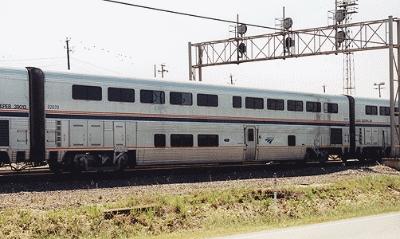$58.78
| Retail $69.98 SAVE 16% ! | |
Out of Stock Discontinued - No longer available for purchase |
Website security verified by GoDaddy.
You Might Also Like
← Swipe To View More →
Features
- Real Metal Finish Simulating Stainless Steel
- ALL Wire Grab Irons Factory-Installed
- Full Upper & Lower Interior
- See-Through Tinted Windows
- Correct Working Diaphragms
- Correct Trucks w/Metal Sideframes
- Metal RP-25 Wheels
- PROTO Max(TM) Metal Knuckle Couplers
- Authentic Lettering & Graphics
- Decal Numbers & Names
- Correct Prototype Details
- Built-In Electrical Contacts for LED Interior Lighting Kit (#933-6004 Sold Separately)
- Superliner I & II Coaches, Lounges, Sleepers & Diners in Phase 2, 3, 4 and 4B Schemes as Appropriate
- Entering service in 1979, Amtrak's bi-level Superliner cars represented a major step forward. The all-new design (built by Pullman-Standard) used a common car body that could be outfitted as a coach-baggage car for short-distance runs, a long-distance coach with larger seats, a sleeper or a diner. In all, 284 cars eventually made up the first fleet, which was put to work on western long-distance runs; at the time, clearance problems in many eastern states prevented running these taller cars on several routes. Prototype features of these cars (later known as Superliner I) include
- A rivet strip running the length of the car body
- Two-panel roof construction
- Earlier Style Trucks - As delivered, cars rode on trucks supported by air bags. These proved unsuitable and were later retrofitted with springs.
- With the passage of the Americans with Disabilities Act in 1992, a second series of cars were constructed by Bombardier to meet new standards for easier access. Designated Superliner II, prototype features include
- Three-panel roof construction * Wider entryways * GSC Style Trucks with stabilizer bracing
- Most of these cars are still in service. Through their careers, they've worn several different schemes (called phases)
- Phase II = Wide red and blue stripes with small white pinstripes
- Phase III = Equal red, white and blue stripes with black logo on white background
- Phase IV = Large blue stripe with small red and white stripes
- Phase IVb = Large blue stripe with small red and white stripes, current Amtrak logo in blue
- Fully assembled and ready for service, these HO models have been completely retooled. They're plated with real metal to simulate the stainless steel of the prototypes, while authentic striping, logos and lettering are printed on the cars. Decal numbers are provided to model a larger fleet.
- Other major upgrades include complete upper and lower interiors, see-through tinted windows, 16 stainless wire grab irons - all factory installed, correct working diaphragms, correct trucks with metal sideframes and RP-25 wheels, diecast PROTO Max knuckle couplers, and built in electrical contacts to power the LED Interior Lighting Kit (#933-6004 sold separately).
Specs
- Walthers Product Number: 932-16112
- Walthers Catalog: 2012 HO, page 132
Requirements & Suggestions
Reviews |
